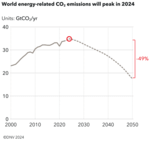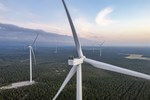Renewable energy deployment surge puts global power system on track for the IEA’s ambitious net-zero pathway
- Complementary research from Systems Change Lab shows eight countries, ranging from Uruguay to Denmark to Namibia, are already proving this is possible, having scaled up solar and wind at rates faster than what’s needed globally to limit global warming to 1.5°C, based on IEA scenarios.
- This exponential growth has put the electricity system at a global tipping point — where the transition away from fossil fuels has become hard to reverse, suggesting fossil fuel demand has peaked in the electricity sector and will be in freefall by the end of the decade.
- The COP28 goal to triple renewables capacity by 2030 is now within reach, provided further barriers are removed, including grid investment, streamlined permitting, improved market structures, and greater storage.
Two new pieces of research show that solar and wind are growing faster than expected:
Rapid growth in solar, wind and battery deployment means that by 2030 the global electricity system can deliver ambitious net-zero pathways, according to new research by RMI done in partnership with the Bezos Earth Fund. This exponential growth in renewable electricity is unlocking widespread benefits, including security of supply and jobs growth, as well as countering energy price inflation.
Complementary research from Systems Change Lab, also published today, shows eight countries have already grown solar and wind generation faster than what’s needed to limit global warming to 1.5°C, proving that a rapid transition to renewable energy is possible.
By 2030, solar and wind is forecast by RMI to supply over a third of all global electricity, up from around 12% today. Based on the forecasts, this would see solar and wind generate 12,000-14,000TWh by 2030, 3-4 times higher compared with 2022 levels. It would also surpass recent calls running up to COP28 for a tripling of total renewable energy capacity by 2030.
Meanwhile, fossil fuel demand for electricity will be in steep decline, according to the RMI analysis, down as much as 30% from the 2022 peak by 2030, as renewable electricity further outcompetes hydrocarbons on cost.
Diverse countries leading the charge
Certain key countries and regions including China and Europe are leading the way in adopting clean energy technology, at an exponential growth rate. However, renewable deployment is also becoming ever more distributed globally, including across the Middle East and Africa, which are rapidly catching up with and harnessing the global growth trend.
Uruguay, Denmark, Lithuania, Namibia, Netherlands, Palestine, Jordan, and Chile have all already grown solar and wind generation at rapid speeds, demonstrating that a rapid transition can be achieved across many different contexts, research from Systems Change Lab shows.
Globally, wind and solar need to grow from 12% to 41% by 2030, an increase of 29 percentage points. Denmark, Uruguay, and Lithuania have already achieved such an increase over a comparable span of eight years. Namibia, the Netherlands, Palestine, Jordan, and Chile have grown solar and wind generation at sufficient rates for five years.
These countries scaled-up wind and solar under very different circumstances. They span both developing and developed countries, with a GDP per capita ranging from $4,000 to $67,000 per year. The countries were driven to accelerate renewables by a variety of factors, including adopting smart and effective policies, maintaining political commitment, lowering the costs of renewable power and improving energy security.
“The exponential growth trend in renewable electricity can be harnessed to help developing countries get ahead of the curve and transition faster to a cleaner and more affordable electricity system,” Andrew Steer, President and CEO of the Bezos Earth Fund.
Cost advantage gives boost to green energy
Exponential rates of deployment are driving down renewable prices at unprecedented pace, rendering higher cost hydrocarbons uncompetitive in most markets.
RMI forecasts that what is already the cheapest form of electricity in history will roughly halve in price again by 2030, falling as low as $20/MWh for solar from over $40MWh currently.
The cost of renewable electricity has plummeted over the past 10 years, overcoming a key barrier to widespread deployment. Solar and battery costs have declined 80% between 2012 and 2022, while offshore wind costs are down 73% and onshore wind costs are 57% down, BNEF data shows.
“Exponential growth of clean energy is an unstoppable force that will put more spending power in the pockets of consumers. The benefit of rapid renewable deployment is greater energy security and independence, plus long-term energy price deflation because this is a manufactured technology – the more you install the cheaper it gets,” said Kingsmill Bond, Senior Principal, RMI.
This comes as the Global Stocktake, which delivers the results of a two-year assessment of global efforts to meet the goals of the Paris Agreements, is expected to highlight a major shortfall in necessary progress to stem the accelerating climate crisis. However, this backward-looking assessment misses the exponential growth of new energy technologies in the largest industries of the fossil fuel system. Electricity and road transport account for more than half of fossil fuel demand and have reached tipping points in deployment to pave the way for wide-spread adoption.
“This is a clear signal to policy makers, businesses and investors to seize the opportunity of accelerating the energy transition. The call to triple renewable electricity investment and capacity by 2030 are deliverable. But only by removing barriers to faster renewable deployment, from streamlining permitting to redirecting subsidies for polluting energy. Otherwise, the exponential growth we are seeing and the benefits that come with it could be derailed unnecessarily,” Christiana Figueres, Former Executive Secretary of UNFCCC and a Founding Partner of Global Optimism.
- Source:
- RMI
- Author:
- Press Office
- Link:
- rmi.org/...
- Keywords:
- RMI, Bezos Earth Fund, analysis, renewable energy, power system, IEA, net zero, pathway, forecast, wind, solar, deliver, cost decline, green

























